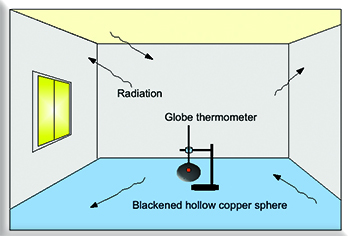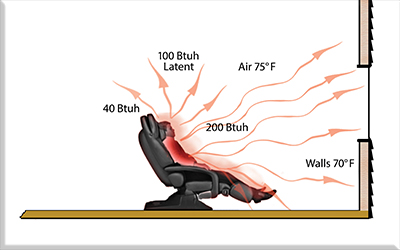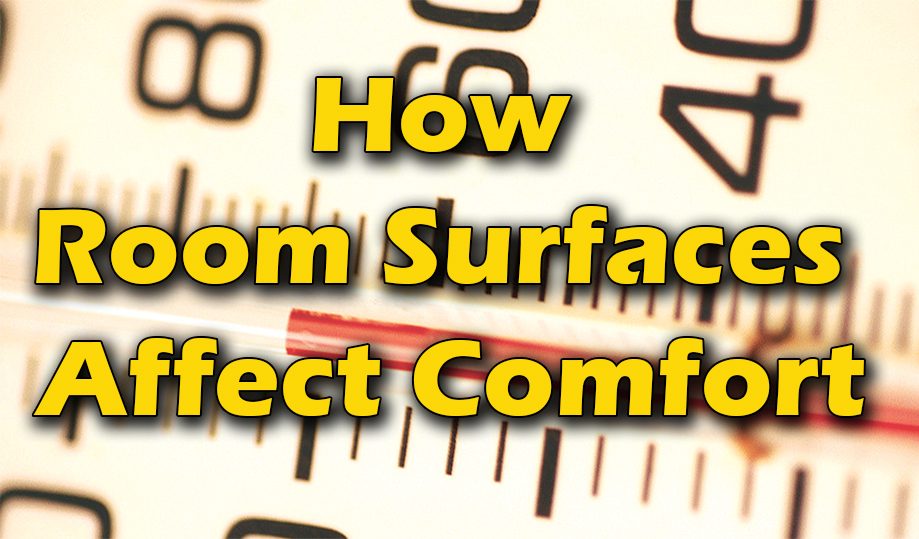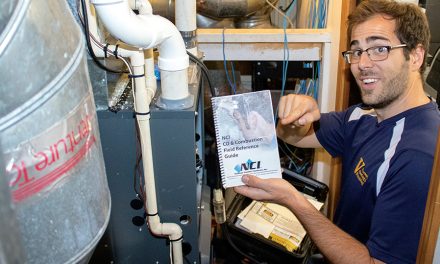For example, a well-insulated envelope would provide a winter environment comprising 75° F room air with inside wall surfaces at a little below 70° F.
The illustration below shows how a person seated at rest might lose heat to his environment. You’d lose around 200 Btuh by radiation to the colder walls and convection to the room air; perhaps you’d lose another 100 Btuh through evaporation.

If a large amount of glass was installed or the walls were uninsulated, the wall surface temperatures would be less than 70° F, and the person would lose more heat by radiation.
Mean Radiant Temperature
Laboratory tests show that surface temperatures are as important as room air temperature to overall comfort. In fact, researchers suggest that increasing or decreasing surface temperatures by 1°F is the same as increasing or decreasing room air temperature by 1°F in terms of the comfort achieved.

Mean radiant temperature (MRT) is one way to measure the effect of inside surface temperatures. You calculate MRT from equations, which consider the various room surface temperatures, or by using a “globe” thermometer illustrated in the figure to the right.
Experts in measuring human comfort often combine room air temperature with a room’s mean radiant temperature to create an improved comfort index. This new index is the “adjusted dry bulb” temperature. You calculate it by averaging the room air temperature and mean radiant temperature.
For example, the adjusted dry-bulb temperature for a room at 75° F with an MRT of 71 would be:

The fact that the building envelope’s thermal characteristics are so important in maintaining comfort means that the air distribution designer must consider inside surface temperatures (especially the amount, type, and location of glass or poorly insulated walls).
Effect of Winter Humidification
As noted, indoor humidity does affect the rate of body heat rejection by evaporation. However, if you only consider residential and office environments, the effect of significant changes in indoor humidity is minimal.
During the heating season, a change from 20% to 60% RH may go practically unnoticed by most occupants. The critical point is that while humidity is a factor in heating season comfort, the human body is more sensitive to slight changes in air and surface temperatures.
Of course, during the cooling season, people have a low tolerance for high humidity, and humidity control becomes more critical.

Effect of Velocity
The human body is sensitive to air movement, especially at rest, like watching TV, reading, working at a desk, etc.
A draft happens when air with a specific combination of air velocity and temperature causes a sensation of coolness, hence the discomfort.
How fast must air move to cause a draft? It depends on which part of the body is affected by the moving air stream.
The chart to the right outlines comfort zones for the neck and ankles for a range of air temperatures and air velocities. At 72° F, air moving at 30 feet per minute (fpm) would be outside the comfort zone near the neck and constitute a draft.
Click Here for the Next Page:













My uncles knew this back in the 1940s. They made the ceilings the radiant heat source in their homes. Their homes were the most comfortable winter homes I’ve ever been in.